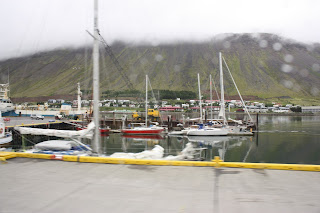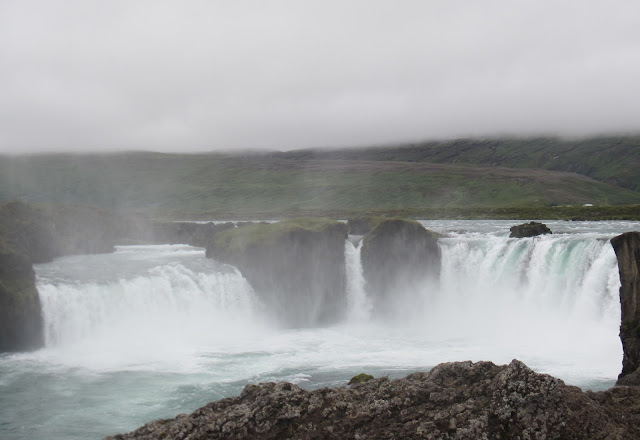 |
| View of scene on way to port |
Prior to disembarking, we heard an hour long lecture on the birds of Iceland. You can see some of the birds at the link to the right and find out some facts on the Facts and Figures page. Our lecturer was who has a wealth of knowledge and degrees.
The Snaefellsnes peninsula is in the west of Iceland. It is much older than the Reykjanes peninsula, where Reykjavik is located.

We disembarked at Grundarfjordur, a fishing village. Half of the workforce is employed in the fishing industry.
We drove to Budir. There were volcanic eruptions 7000 years ago. There was lava and basalt rock all over. Piles of stones and stakes tell where the road is along the way. In the mis 1800s huge floods wiped away the coastal villages.
We arrived Budir bay which has lots of little islands. We took a 40 minute walk with a stop at the Black Church (Lutheran) to a white sand beach with lava all over.





Our next stop was Arnarstapi where one group took a 45 minute cliff walk and we took an alternate walk on top. We saw the cliffs and then a statue of Bardur Snaefellsas, the deity of Mt. Snaefell, the introduction of which was in a 14th century saga.

The last stop of the day was Djupalonssandur. Here people took a 30 minute walk down to the black sand beach. Several of us took a walk on the boardwalk at the top. It was extremely windy and Diane had to take the arm of another woman and then another took hers. It felt like the wind would blow us over.









 Our next stop was Geysir & Stokkur - 2 geysers. The Great Geysir hasn't erupted since 2000 but the Stokkur erupts about every 15 minutes and reaches a height of 66ft. There were also many water pools along the path.
Our next stop was Geysir & Stokkur - 2 geysers. The Great Geysir hasn't erupted since 2000 but the Stokkur erupts about every 15 minutes and reaches a height of 66ft. There were also many water pools along the path.





 Our first destination was a beautiful waterfall with cold, clear and refreshing water. To watch a video and hear the rushing go here http://ow.ly/RPPhm. To get a drink of the fantastic water you have to go there.
Our first destination was a beautiful waterfall with cold, clear and refreshing water. To watch a video and hear the rushing go here http://ow.ly/RPPhm. To get a drink of the fantastic water you have to go there.
 We next went to Osvor to see a turf-roofed fisherman's house and learn about the life of an Icelandic fisherman a few generations ago
We next went to Osvor to see a turf-roofed fisherman's house and learn about the life of an Icelandic fisherman a few generations ago
 Akureyri is the "capital of northern Iceland" - it is the commercial, cultural, and governmental center of the north. It is the largest fishing port. The 16,000 inhabitants work in fisheries, light industry, and food processing. The climate is mild despite being only 60km from the Arctic Circle. In the winter Akureyri is the winter sports center and provides many tours of the Aurora Borealis. In the winter there is only 3 hours of daylight. In the summer people hike and garden, young people sail boats. Kids play outside until the 10PM curfew. People love to swim and bathe in mineral baths year round.
Akureyri is the "capital of northern Iceland" - it is the commercial, cultural, and governmental center of the north. It is the largest fishing port. The 16,000 inhabitants work in fisheries, light industry, and food processing. The climate is mild despite being only 60km from the Arctic Circle. In the winter Akureyri is the winter sports center and provides many tours of the Aurora Borealis. In the winter there is only 3 hours of daylight. In the summer people hike and garden, young people sail boats. Kids play outside until the 10PM curfew. People love to swim and bathe in mineral baths year round. Godafoss (Waterfall of the Gods) was named in 1000 AD when the Law Speaker of the Parliament proclaimed Iceland a Christian country and he threw all his pagan statues into the falls. The water from the river falls from a height of 12 meters over a width of 30 meters.
Godafoss (Waterfall of the Gods) was named in 1000 AD when the Law Speaker of the Parliament proclaimed Iceland a Christian country and he threw all his pagan statues into the falls. The water from the river falls from a height of 12 meters over a width of 30 meters.


 We disembarked at Grundarfjordur, a fishing village. Half of the workforce is employed in the fishing industry.
We disembarked at Grundarfjordur, a fishing village. Half of the workforce is employed in the fishing industry.



 Our next stop was Arnarstapi where one group took a 45 minute cliff walk and we took an alternate walk on top. We saw the cliffs and then a statue of Bardur Snaefellsas, the deity of Mt. Snaefell, the introduction of which was in a 14th century saga.
Our next stop was Arnarstapi where one group took a 45 minute cliff walk and we took an alternate walk on top. We saw the cliffs and then a statue of Bardur Snaefellsas, the deity of Mt. Snaefell, the introduction of which was in a 14th century saga.